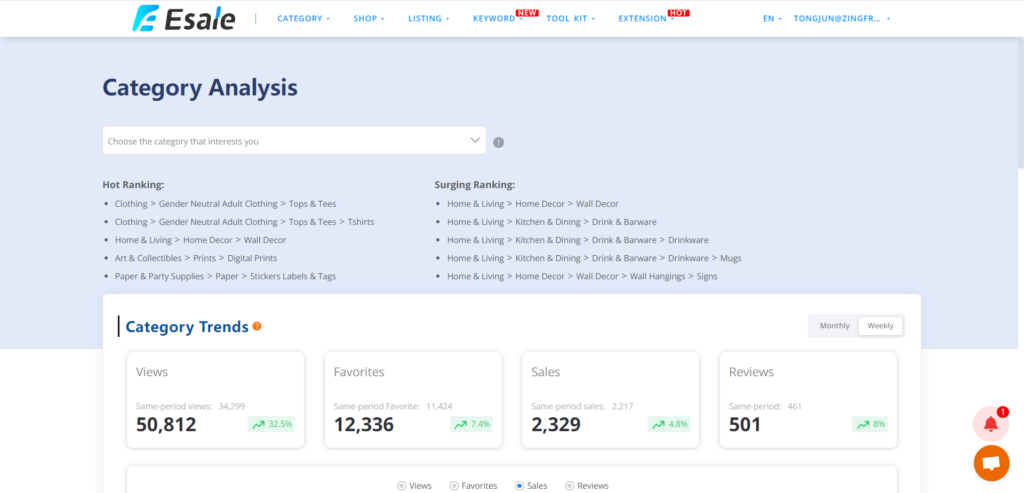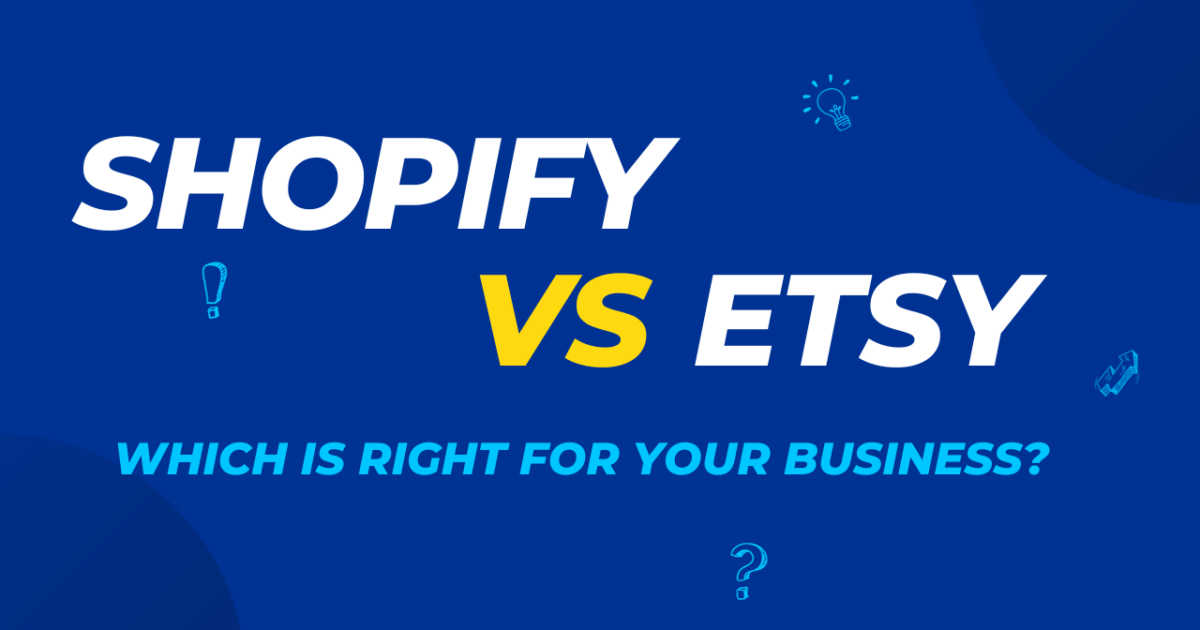Selling Handmade Goods: A Beginner’s Guide to Starting an Etsy Shop

To begin your Etsy journey, follow these steps:
Step 1: Create an Account
The first step in starting your Etsy shop is to create an account on the platform. Visit the Etsy website and click on "Sell on Etsy" to get started. You'll be prompted to sign up with your email address or use an existing Google or Facebook account. Choose a username that reflects your brand or shop name for easy recognition.
Step 2: Set Up Your Shop
Once you've created an account, it's time to set up your shop. Click on "Open Your Etsy Shop" and provide all the necessary information, including your shop name, language preference, currency, and location. Take some time to think about your shop name as it will become part of your brand identity.
Step 3: Customize Your Shop
Now that you have set up your shop, it's time to make it visually appealing and unique. Customize your shop by adding a banner image that represents your brand aesthetic. You can also create a logo or use a high-quality photo of one of your products as the profile picture for instant recognition.
Step 4: Add Listings
Listings are where you showcase each individual product in your shop. Click on "Add a Listing" and provide detailed information about your handmade goods. Include high-quality photos, accurate descriptions, pricing, and shipping details. Be sure to optimize your listings with relevant keywords that potential customers might search for.
Step 5: Establish Shop Policies
Shop policies are essential for setting expectations with your customers. Clearly define your policies regarding shipping, returns, exchanges, and any other relevant information. This helps build trust and ensures a smooth buying experience for your customers.
Step 6: Promote Your Shop
Once your shop is up and running, it's time to promote it to attract potential buyers. Utilize social media platforms like Instagram, Facebook, and Pinterest to showcase your products and engage with your target audience. Collaborate with influencers in your niche or run targeted ads to reach a wider audience.
Starting an Etsy shop is an exciting venture that allows you to share your passion for handmade goods with the world. By following this beginner's guide, you'll be well on your way to creating a successful online store on Etsy. Stay tuned as we delve deeper into topics such as branding, photography tips, payment settings, shop policies, and more in the upcoming sections of this blog post.
Remember, starting an Etsy shop is just the beginning of an incredible journey filled with creativity and opportunities. So let's dive in and make your dreams of selling handmade goods a reality!
Step 7: Using some marketing tools
When you're a passionate Etsy seller, you understand the pivotal role of selecting the right products. Enter Esale – your indispensable ally and the secret weapon to boost your sales!
Esale is not just a product selection tool; it's your guiding force to success, helping you discover the most sought-after items. By conducting in-depth analyses of market trends and key data, Esale tailors recommendations to ensure your shop stays at the forefront of trends.
Whether you're in search of unique handcrafted items, artistically designed pieces, or tapping into popular fashion trends, Esale has you covered. Its intuitive interface and smart algorithms simplify the product selection process, allowing you to focus on creation rather than getting bogged down in tedious market research.
Don't let competition deter you. Esale's market analysis tools provide real-time competitive intelligence, assisting you in optimizing pricing and promotional strategies to ensure your products always remain competitive.
Make Esale your Etsy companion and watch as your shop gains more exposure and sales opportunities. No more trial and error – let data guide your decisions and lead you to greater success! Try Esale and make your Etsy journey more enjoyable and successful than ever!

Creating a Memorable Brand Identity
In the world of online selling, establishing a memorable brand identity is crucial for success. Your brand is what sets you apart from competitors and helps customers recognize and remember your shop. It encompasses everything from your shop name to your logo, color scheme, packaging, and overall aesthetic. Let's explore why branding is important and how to choose a memorable shop name.
The Importance of Branding
Branding goes beyond just having a visually appealing logo or shop design. It represents the values, personality, and unique selling proposition of your business. Here are some key reasons why branding is essential for your Etsy shop:
- Differentiation: In a crowded marketplace like Etsy, having a strong brand identity helps you stand out from the competition. It allows you to carve out a niche for yourself and attract customers who resonate with your style and offerings.
- Recognition: Consistent branding creates familiarity among customers. When they see your logo or packaging, they should immediately associate it with your products and quality. This recognition builds trust and encourages repeat purchases.
- Credibility: A well-established brand conveys professionalism and credibility. Customers are more likely to trust shops that have invested time and effort into creating a cohesive brand identity.
- Emotional Connection: Brands that evoke emotions in their customers create lasting connections. By aligning your brand with values or themes that resonate with your target audience, you can foster loyalty and advocacy.
Choosing a Memorable Shop Name
One of the first steps in creating your brand identity is selecting a memorable shop name that reflects your business's essence. Here are some tips to help you choose an impactful shop name:
- Reflect Your Brand: Your shop name should align with the products you sell and convey the overall vibe of your business. Consider whether you want it to be playful, elegant, whimsical, or minimalist.
- Keep It Simple: Choose a shop name that is easy to remember, spell, and pronounce. Avoid using complex or obscure words that may confuse potential customers.
- Consider SEO: While it's important to have a memorable shop name, also consider its search engine optimization (SEO) potential. Incorporate relevant keywords related to your niche or products to improve your shop's visibility in search results.
- Check Availability: Before finalizing your shop name, make sure the corresponding domain name and social media handles are available. Consistency across platforms helps reinforce your brand identity.
- Get Feedback: Share potential shop names with friends, family, or fellow Etsy sellers to get their input. They can provide valuable insights and help you choose a name that resonates with your target audience.
Remember, your shop name is just one aspect of your overall brand identity. As you progress in building your Etsy business, you'll have opportunities to further develop and refine your brand through visual elements, packaging choices, customer interactions, and more.
By investing time and thought into creating a memorable brand identity for your Etsy shop, you'll be well-positioned to attract customers who appreciate the uniqueness of your handmade goods. So let your creativity shine through as you choose a captivating shop name that sets the tone for your brand!
Writing Descriptions That Sell
When it comes to selling handmade goods on Etsy, crafting compelling product descriptions is essential. Your descriptions should not only provide accurate information about your products but also engage potential buyers and persuade them to make a purchase. Let's explore how you can write descriptions that sell and optimize them for better search visibility.
Crafting Compelling Product Descriptions
- Highlight Unique Features and Benefits: Start by showcasing the unique features and benefits of your handmade goods. What sets your products apart from others? Is it the materials used, the craftsmanship, or any special techniques? Clearly communicate these aspects to capture the attention of potential buyers.
- Use Persuasive Language and Storytelling: Engage your audience by using persuasive language in your descriptions. Tell a story about your products, their inspiration, or how they are made. Create an emotional connection with potential buyers by describing how your handmade goods can enhance their lives or solve a problem they may have.
- Focus on Customer Benefits: While it's important to describe the technical details of your products, don't forget to emphasize the benefits for customers. How will owning your handmade goods improve their lifestyle or bring them joy? Paint a picture of how your products can enrich their lives.
- Keep It Concise and Easy to Read: Online shoppers have short attention spans, so keep your descriptions concise and easy to read. Use bullet points or short paragraphs to break up text and make it scannable. Highlight key information such as dimensions, materials used, care instructions, and any customization options available.
Optimizing Keywords in Descriptions
- Incorporate Relevant Keywords Naturally: Including relevant keywords in your product descriptions helps improve search visibility on Etsy. Incorporate keywords naturally throughout the description without overstuffing them. Focus on using keywords that accurately describe your product while maintaining readability.
- Avoid Keyword Stuffing: While it's important to optimize your descriptions with keywords, avoid keyword stuffing. Search engines penalize websites that engage in this practice. Instead, focus on providing valuable information and writing descriptions that resonate with potential buyers.
- Write for Humans, Not Just Search Engines: While optimizing for search visibility is important, remember that you are ultimately writing for human readers. Your descriptions should be informative, engaging, and persuasive. Strike a balance between incorporating keywords and creating a compelling narrative that appeals to your target audience.
- Research Relevant Keywords: Conduct keyword research to identify relevant terms and phrases that potential buyers might use when searching for products like yours. Incorporate these keywords naturally into your descriptions to improve their discoverability on Etsy.
By crafting compelling product descriptions and optimizing them with relevant keywords, you can effectively communicate the value of your handmade goods and attract potential buyers. Take the time to write unique and engaging descriptions for each of your products, as they play a crucial role in driving sales on Etsy.
So let your creativity shine through as you write descriptions that sell – capturing the essence of your handmade goods while enticing customers to make a purchase!
Navigating the Costs: Etsy Fee Structure Explained
Understanding the fee structure on Etsy is essential for managing your costs and maximizing your profit. By familiarizing yourself with the various fees associated with selling on Etsy, you can calculate your expenses and factor them into your pricing strategy. Let's explore the Etsy fee structure in detail and discuss ways to optimize costs while maximizing profitability.
Understanding Etsy's Fee Structure
- Listing Fees: Etsy charges a small fee for each item you list in your shop. This fee covers the cost of hosting your listings on their platform. It's important to note that listing fees apply regardless of whether an item sells or not.
- Transaction Fees: When you make a sale on Etsy, they charge a transaction fee based on a percentage of the item's sale price, including shipping costs. This fee covers payment processing and other services provided by Etsy.
- Other Charges: In addition to listing and transaction fees, there may be other charges associated with selling on Etsy, such as currency conversion fees or fees for optional services like promoted listings or pattern by Etsy.
Optimizing Costs and Maximizing Profit
- Reduce Expenses without Compromising Quality: Look for ways to reduce expenses without compromising the quality of your handmade goods. Consider sourcing materials in bulk or finding more cost-effective alternatives without sacrificing the integrity of your products.
- Regularly Review and Adjust Pricing: Regularly review your pricing strategy to ensure that it aligns with your costs and desired profit margins. Take into account all applicable fees when setting prices for your products so that you can maintain profitability while remaining competitive in the market.
- Evaluate Shipping Costs: Shipping costs can significantly impact your overall expenses. Research different shipping carriers and options to find the most cost-effective solutions for delivering your products to customers without compromising delivery times or quality of service.
- Consider Packaging Efficiency: Optimize your packaging process to minimize waste and reduce shipping costs. Use appropriate packaging materials that protect your products while keeping dimensions and weight in mind to avoid unnecessary expenses.
- Track and Analyze Expenses: Keep track of all expenses related to your Etsy shop, including fees, materials, packaging, and shipping costs. Regularly analyze these expenses to identify areas where you can make adjustments or find cost-saving opportunities.
By understanding the fee structure on Etsy and implementing strategies to optimize costs, you can maximize your profit margins while maintaining the quality of your handmade goods. Regularly review and adjust your pricing strategy based on changes in expenses or market conditions to ensure long-term profitability.
Remember, finding a balance between competitive pricing and profitability is key to running a successful Etsy shop. By managing costs effectively, you can navigate the fees associated with selling on Etsy while maximizing your earnings.
Embark on Your Etsy Journey Today
Congratulations! You are now equipped with the knowledge and guidance to start your own successful Etsy shop. It's time to turn your passion for handmade goods into a thriving business and showcase your unique products to a global audience. Follow the steps outlined in this beginner's guide, and let your creativity shine as you embark on your Etsy journey.
Starting an online store on Etsy offers numerous opportunities and advantages. Here are some key reasons why you should take advantage of what Etsy has to offer:
- Global Reach: With millions of active buyers from around the world, Etsy provides a platform that allows you to reach customers far beyond your local market. Take advantage of this global reach to expand your customer base and increase sales.
- Showcase Your Unique Products: Etsy is known for its focus on handmade, one-of-a-kind items. This gives you the opportunity to showcase your creativity and craftsmanship, setting yourself apart from mass-produced products found elsewhere.
- Access to a Supportive Community: Joining Etsy means becoming part of a vibrant community of sellers who share similar passions and challenges. Engage with fellow sellers through forums, teams, or social media groups to gain insights, support, and inspiration.
To get started on your Etsy journey:
- Create Your Shop: Sign up for an account on Etsy and follow the prompts to set up your shop. Choose a memorable name that reflects your brand identity and complete all necessary information.
- Craft Compelling Listings: Create eye-catching listings by using high-quality product photos, detailed descriptions, and accurate pricing information. Incorporate relevant keywords naturally into titles, tags, and descriptions for better search visibility.
- Establish Clear Shop Policies: Craft clear shop policies that cover shipping, returns, exchanges, and any other relevant areas. Clearly communicate these policies to set customer expectations from the beginning.
- Promote Your Shop: Utilize social media platforms like Instagram, Facebook, and Pinterest to showcase your products and engage with your target audience. Collaborate with influencers or run targeted ads to expand your reach.
- Deliver Exceptional Customer Service: Provide excellent customer support by responding promptly to inquiries, addressing concerns, and going the extra mile to ensure a positive buying experience for your customers.
Remember, building a successful Etsy shop takes time, effort, and dedication. Continuously learn from your experiences, adapt to market trends, and refine your strategies as you grow. Stay true to your brand identity and let your passion shine through in everything you do.
So what are you waiting for? Start your Etsy journey today and turn your passion for handmade goods into a thriving business. Follow the steps outlined in this beginner's guide, embrace the opportunities that Etsy offers, and watch as your unique products captivate customers worldwide. Good luck on your exciting Etsy adventure!





